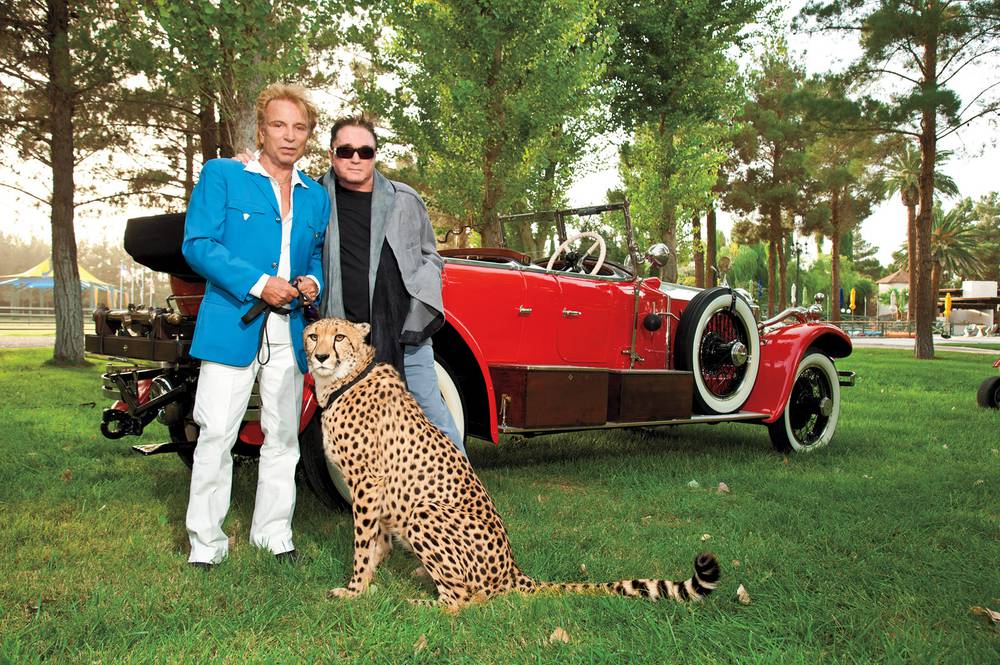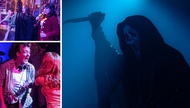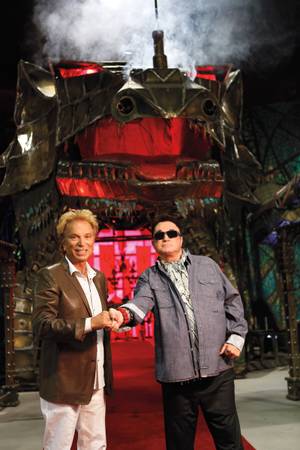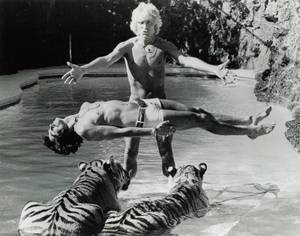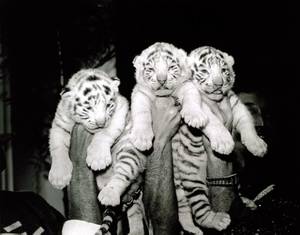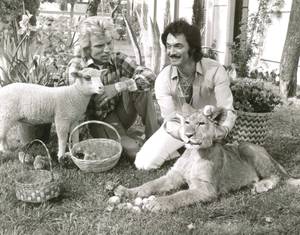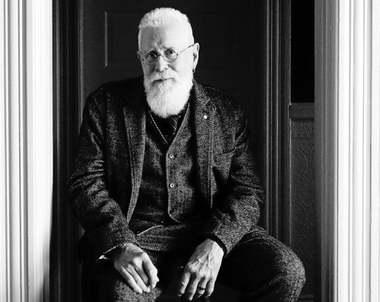Siegfried & Roy: 10 Years Later
The compound is known as Little Bavaria, but referring to this sprawling estate as “little” seems farcical. This is a staggering hideaway of connected mansions, with fields as vast as a dozen soccer pitches, an aquatic park that rivals the Bellagio fountains, and miles of interlocking walkways that encircle and cut through the property.
Hip-high rails have been constructed along those winding sidewalks, so Roy Horn has something firm and steady on which to lean as he makes his way around, visiting Little Bavaria’s animal kingdom, which includes horses, mini-donkeys, black swans, exotic chickens, African cranes, royal turkeys, canines and assorted cats, big and small. Siegfried Fischbacher ordered those rails built, once more providing support to his friend, life companion, performing partner and co-founder of a Strip show that entertained more than 25 million fans for more than 35 years. Siegfried also enforced the construction of a new house outfitted to offset Roy’s physical limitations, suffered a decade ago when he was dragged offstage by a white tiger named Montecore during a performance at the Mirage. October 3 marked the 10-year anniversary of that incident, which Siegfried and Roy alternately refer to as “the accident” or “the thing,” as in, “When the thing happened ...”
But they hardly speak of it, and only when asked.
Instead, they strive to remain relevant, in the here and now. Like Little Bavaria itself, they are still growing, in their personal and professional relationship.
“Las Vegas implodes everything,” Siegfried says as he cups a cigarette in his right hand, smoke seeping mysteriously from his grip as if he’s performing a sleight-of-hand illusion. “But here, we keep building. We will not be knocked down.”
Siegfried is quick apace as he leads this tour of Little Bavaria, and seems as excited as someone seeing it for the first time. “Nobody comes here to us,” he says, referring to what really is Siegfried and Roy’s secret garden. “We let very few people in here.”
Little Bavaria was built 25 years ago, but is always evolving. It’s one of the duo’s two Las Vegas residences; the more widely known Jungle Palace is across the street from Las Vegas Municipal Golf Course. Siegfried recently sold a third home in Spanish Trails, and today, he and Roy spend most of their time at Little Bavaria.
“This is 100 acres, and we have all the water rights, which is why we can build the big pools. We could not build Little Bavaria today,” Siegfried says. “There are too many restrictions … Out here, you are not in Las Vegas.
“There is a center house [where] we spend time together,” he says of a dwelling that overlooks the lake-sized pool. “We have houses on each side, one for Roy and one for me. They are like two arms, wrapped around, and we meet in the middle.”
Siegfried points out an ornate chess board that has become emblematic of Roy’s recovery, as he moved from rudimentary games to lengthy battles with Siegfried. Nearby is a small church, three pews on each side with a tall, wooden crucifix high on a wall.
Siegfried’s tour doubles as a Roy reconnaissance mission. “Where is he? He should be here by now,” Siegfried says to no one in particular. He exits the church through a heavy side door, which closes with a thick “thump.” Then, he spins around and tries to re-enter the room. “Locked! It is locked now!” he says, smiling but exasperated. “I am now locked out! I have no way to get back in! I need to find Roy! This is the life of my story!”
The words hang in the air: the life of my story. The great Siegfried Fischbacher has just performed some verbal magic. It’s a funny turn of phrase, but one that makes perfect sense.
"If a tiger attacks you, you are finished." -Roy Horn
As a member of the Little Bavaria maintenance staff hustles off to find a key, Roy appears, as if emerging through a haze of stage fog. He’s in the passenger seat of a red golf cart, which pulls to a stop beside a golden gong familiar to anyone who saw Siegfried & Roy’s show at the Mirage.
“When he wants me to know he is here and is coming inside, he lets me know,” Siegfried says, nodding toward the gong.
Roy slams his closed, gloved hand into the gong, causing a heck of a racket. His hands are strong, and when he grasps for a handshake, he squeezes with enough force to send a quick thread of pain through your wrist.
“He will also ring the bell,” Siegfried says, pointing to a bell tower that shadows the residences. Roy pulls a rope to make the bell sound. “The neighbors, they love us,” Siegfried says.
Siegfried and Roy take seats at their dining-room table, along with the woman who was their onstage partner for decades and still watches over the duo, Lynette Chappell. Onstage she was dubbed the Evil Queen, a description she once said “is true on and off the stage,” but while Chappell can be stern in keeping “the guys” on schedule, she is an angel in Siegfried and Roy’s universe who has served as friend, assistant, confidant and—over the past 10 years—constant caregiver for Roy.
As they talk of the week ahead, the date looms: October 3. The 10th anniversary of “the thing,” and also Roy’s 69th birthday. He constantly jokes about his birthday celebration, claiming that the formal reunification of Germany on October 3, 1990 was “a birthday present to me.” He also jokes that the car Siegfried and Roy presented at the Barrett-Jackson automobile auction recently at Mandalay Bay, a 1925 Rolls Royce Phantom once owned by the Maharaja of Kotah, was being hauled to Las Vegas “as a present to me.”
“No, no, no, no, no! Not true!” Siegfried says. “That is just what you think!”
“It’s a million-dollar car,” Roy says, ignoring Siegfried’s excited clarification, “and it is for me.”
This sort of back-and-forth is characteristic of Siegfried and Roy. Asked if the duo is like a couple married for decades, Siegfried swiftly agrees. “Ya,” he says. “It is 55 years for us. It was not always like this for us. We have had our ups and downs, but when I am home, it’s Roy’s home, too.”
“We are still a team,” Roy says, as if completing the thought.
And how is Roy?
“Only Roy can answer this,” says Siegfried, who often finishes off sentences or translates Roy’s heavily accented verbal bursts.
“The news about my death has been greatly exaggerated,” says Roy, who never lost his sense of humor. “I feel I am a very good-looking corpse.”
Roy once spoke of his acute pain, so intense that early in his recovery he became addicted to pain medication, which led to a different sort of recovery. “Pain is my best friend,” he says now. “I have to live with it. [But] I am doing pretty well. I am a little bit handicapped, but I’m not an invalid. I can do a lot of things. I can walk, I can go swimming, I can go to the gym, I can go shopping.”
Is there anything he’s unable to do that he wants to do?
“No,” Roy says.
“He does whatever he wants to do,” Siegfried adds.
Siegfried has been at Roy’s side constantly during the intensive rehabilitation workout sessions. For years, the two have been spotted together, along with one or two caregivers, at Las Vegas Athletic Club. Siegfried calls out, “You’re doing it!” forcing Roy to finish off a set of repetitions.
“He is a slave driver,” Roy says.
Somehow, as if supplying a syrupy soundtrack to the conversation, Foreigner’s “I Want to Know What Love Is” comes on the home’s sound system.
“He cheers me up,” Siegfried says. “He shows me how to live. He tells me how to live. He is not just sitting in a corner. He says to me, ‘Do not worry about what you don’t have; enjoy everything that you do have.’”
“I am very grateful, every day, for every breath I am taking,” Roy continues, cutting again into Siegfried’s comments. “That is my message to anyone who has had a stroke or a heart attack: Keep moving. Make progress. Pull yourself together, because you can do it.”
"He's my brother." –Roy Horn, on Montecore
On the night of “the thing,” Montecore was introduced as making his first-ever stage appearance in a Siegfried & Roy stage show. But that was just a showbiz moment, stated for effect. Montecore was 6 years old and had performed in dozens of shows at the Mirage.
So, what was different on the night of October 3, 2003? What led to Montecore clamping on Roy’s neck and dragging him from the stage?
“I had high blood pressure at that time, and because of the energy level of the show, I got excited and passed out onstage and fell, unfortunately,” Roy says.
What does he remember from that night?
“Montecore looked at me with his big blue eyes and was confused, and so he picked me up by the neck,” Roy says. “He brought me to the side so he could attend to me.”
He continues, “But we need to rectify—he never attacked me. If a tiger attacks you, you are finished.”
Siegfried echoes, “When a tiger attacks you, you are finished.”
When asked about the validity of other reports of that night, such as Steve Wynn’s account of a woman in the front row wearing a big hairdo, who drew Montecore to the edge of the stage, Siegfried’s voice rises.
“We have told this story so many times! You know the media!” he says. “They want to have the blood—which was there, no question about it. This was right in the middle of the audience. Of course, you have the headlines: ‘Roy has been attacked by a tiger.’ I understand, I was there, and I have lived with the possibility of this happening all of my life, with Roy and the animals. But what happened with Montecore, Roy passed out. This was not an attack.
“It was an accident. It was an accident.”
Putting Montecore down was never considered by Siegfried and Roy, and today the big cat is a senior citizen by white tiger standards, 16 years old and living in Vegas.
“He is at Secret Garden sometimes, appearing there,” Siegfried says. “He is sometimes at Jungle Palace, and sometimes he comes here.”
Has there been any change in how the two interact with Montecore?
“There has been no change,” Siegfried says, “absolutely not.”
“Montecore is fabulous,” Roy says. “He’s my brother.”
“When you see that, when you see Roy’s face when he is with Montecore, it brightens,” Siegfried says. “It’s as if nothing happened, you know?”
Roy adds, “I give him love.”
He recalls a Montecore story, familiar in the Siegfried and Roy circle. When the tiger cub was born, he stopped breathing. Roy cut the umbilical cord and breathed life into the cub that would grow up to be famous around the world for unwittingly halting the Siegfried & Roy show forever.
“I remember him starting to breathe again,” Roy says. “I was so grateful for that.”
As Roy speaks, Siegfried nods. “It all stopped so suddenly,” Siegfried says. “The stage—that was our thing. It was growing in our show, it was growing up together.”
How is the fable of Siegfried and Roy anything but a love story?
“It is that, yes,” Siegfried says. “I never realized I was good until I met Roy. I always just tried to be good, but I never really knew I was good until we became a team. The way I grew up, I really had no confidence in what I was doing.
“The first time I showed a magic trick to my father, it was the first time he noticed me, it seemed like,” Siegfried says. “He said, ‘How did you do that?’ These five words from my father—he finally noticed me!”
Roy cuts in, “We share the same mistress, magic.”
The pair accepts due credit for changing the trajectory of entertainment in Las Vegas, where the concept of a production show starring magicians was scoffed at until they started dazzling audiences on the Strip in the late 1960s.
“When we started at Lido de Paris [at the Stardust], we were a team. We were one,” Roy says. “We have changed a lot in Vegas.”
“It’s family entertainment. That’s what we started,” Siegfried says, picking up the thought. “These are big production shows now, but yeah, we came from nowhere. And when the Mirage became such a success, Steve Wynn knew how important entertainment was, and he knew how important Siegfried & Roy were. The show was sold out every night from the first night to the last.”
Soon Las Vegas wanted “similar shows” in size and spectacle to match what Siegfried & Roy were rolling out at the Mirage.
“Cirque du Soleil came in, you know, and Steve Wynn started that concept of Cirque in Las Vegas,” Siegfried says. “The same thing that we inspired, Cirque du Soleil, inspired him. It was a real business decision, because he knew Siegfried & Roy, the moment we hit the Strip …”
“We were always No. 1,” Roy finishes.
"We have been through all of this together." –Roy Horn
Siegfried and Roy do indulge in a bit of pre-Vegas nostalgia. Siegfried had left home as a teenager to work in a small resort hotel in Lago di Garda, Italy. First he was a dishwasher, then a bartender and soon a host who entertained guests with close-up magic. He was hired as a steward on the TS Bremen luxury liner and performed magic for the crew. When the captain of the vessel found out, he told Siegfried to start performing for the passengers, too.
Roy was a waiter on the ship who had developed an affection for animals, which he used to develop a keen understanding of the most exotic creatures on the planet. He joined Siegfried as a partner, on and off the stage. The two would never headline or operate as soloists. It was always Siegfried & Roy.
“I asked Roy—and this is part of our story from a hundred years ago—if he would help me out on the ship, and the audience loved it and was very happy,” Siegfried says.
Roy adds, “Everyone in Europe knew us. People in Switzerland, France, everywhere … and you were seasick, every day.”
“Huh?” Siegfried asks, startled.
“Every day, you were seasick.”
“Oh, of course I was. Right,” Siegfried says. “I was seasick a lot, and he helped me out. But the real change was, we one day had a passenger on our ship—Frau Fritz, who had a nightclub in Breman, Germany. She said, ‘You know, Siegfried, I saw you and Roy last night, I liked that very much. I have this nightclub. Why don’t you do it in my nightclub?”
“It was a new gig,” Roy says. “At the Astoria Theater.”
Fritz told the pair she couldn’t pay much, but they saw an irresistible opportunity. “We knew the nightclub, there were professional entertainers there, and we could be part of it,” Siegfried says. “That changed everything for us.”
When asked if they’ve ever considered performing solo, Siegfried answers quickly.
“No,” he says.
“We have been through all of this together,” Roy adds.
Soon, the two split up to head over to the giant Little Bavaria warehouse for a quick photo shoot with Cruella, the sinister, smoking dragon inspired by Cruella de Vil from 101 Dalmatians and used in the stage show. Roy takes the golf cart, but Siegfried wants to walk. He takes Little Bavaria’s scenic route, too. It’s a rare moment to talk to Siegfried at length without Roy at his side.
Would he and Roy ever return to producing or presenting rising magicians or a production show?
“We have had [magician] Darren Romeo in the past,” he says. Romeo was an afternoon headliner at the Mirage for a time and is now performing in Branson, Missouri. “We had the show Havana Nights, at the Stardust, that was a Siegfried & Roy Presents show. But this does not interest me now.”
One idea that has been floated, mostly as a titillating concept, is for the 74-year-old Siegfried to join the cast of a contest show, like Dancing With the Stars. Siegfried is a graceful dancer. Would he consider such a move?
“You would not believe how many offers I have had to do these shows in Germany,” he says. “You are either judging, or being judged. It is not for me.”
He says he is happier than ever, including the years when the Siegfried & Roy act was pulling in nearly $60 million a year and selling out the Mirage.
“I was once asked if I was happy, with all of the success we have had, and I said, ‘I am happy when I am onstage,’” Siegfried says. Then he stops walking. “Yes. Okay. But that is only three hours of a day, when we were onstage. The day has 24 hours. Now, I have to work and am working still to be 24 hours happy. It has worked, because I am with Roy. You know, even when we signed a contract, it was always ‘Siegfried & Roy,’ like a marriage.”
Though the night of October 3, 2003 marked the permanent end of the Siegfried & Roy production show, Siegfried had grown weary of performing—and of running what he calls “a major corporation called Siegfried & Roy”—by then.
The duo had made a splash by signing a “lifetime contract,” trumpeted by longtime manager Bernie Yuman, with the Mirage three years before “the thing” happened. But it is possible, even likely, that the act might have ended in a more traditional manner by now.
“What had happened was, I was getting very tired, and they came to me and asked, ‘What can we do to make you happy?’” Siegfried recalls. “I said, ‘One show [per night], with the same conditions.’ And Roy said, ‘All right, we will do this.’ All of our lives we’d worked two shows per night.”
They performed that new schedule just one time.
“The day that contract started, that very day, when we went to one show, that’s when the accident happened,” Siegfried says.
He reflects on what made the act—two men from overseas who blended magic and exotic animals—so popular for so long. “He is so, so different than I,” Siegfried says as he nears the warehouse that stores the duo’s many set pieces, along with a blue Rolls Royce once owned by Greta Garbo. “I would say he is more egocentric and I am more humble, you know? Sometimes it’s no good to be too humble. Sometimes it’s no good to be too egocentric. So what has happened is, I took him down, he pulled me up, and we met in the middle. That is Siegfried & Roy.”
"When I played it, I saw a tear run down his cheek." –Siegfried Fischbacher
An exhibit in a glass case in the Little Bavaria warehouse shows a stuffed white tiger rising from an opening in the stage during a Siegfried & Roy show. It is a depiction, created by Siegfried, of the act that presented Montecore to the audience at the Mirage. As the moment is re-created in miniature, a beautiful violin piece plays in the background. The song is “Meditation” from the opera Thais, which provided spirited anticipation to the arrival of the big cat in the Siegfried & Roy show.
In the days after “the thing,” Roy Horn lay unconscious in a hospital bed at UCLA Medical Center. He had undergone surgery to remove 25 percent of his skull, which was stitched into his abdomen, to alleviate the pressure of the swelling of his brain. The procedure is known as decompressive craniectomy, a somewhat obscure medical term that became far more recognizable to the general public as a result of “the thing.”
Roy had gone “code blue” three times the night he was rushed out of the Mirage, and was still in critical condition. The prognosis for him returning to consciousness, or even surviving, was unclear at best. Then Siegfried played a recording of “Meditation” for his stricken partner.
“When I played it, I saw a tear run down his cheek,” Siegfried says. “I knew then he could hear this piece, he understood it, and everything would be okay.”
Standing just an arm’s length away, Roy listens to Siegfried talk of that moment. There is a pause as Roy exhales, and then, in a hushed tone, he says simply, “Life is our stage now.”
